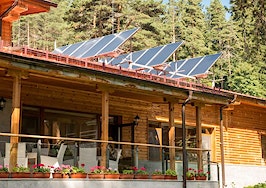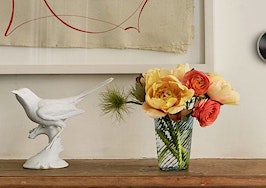Have suggestions for products that you’d like to see reviewed by our real estate technology expert? Email Craig Rowe.
The emergence and adaptation of artificial intelligence (AI) in the form of smart home technology has in recent years blurred the line between traditional homes and smart homes.
But the National Association of Home Builders’ (NAHB) 35th Annual New American Home has in its walls and wires the answer to the question: “What makes a home smart?”

The New American Home presented at the International Builders Show in Orlando. Photo by Jeff Davis
Is it the presence of an Amazon Echo or Google Home device? What about a smart thermostat on the wall? Promoted at last week’s International Builders Show in Orlando, the New American Home demonstrates that a smart home is defined by what takes place behind the walls, not what sits on the counter.

Photo by Jeff Davis
The 6,678-square-foot smart house, currently on the market for $4.2 million, was built by Legacy Custom Built Homes (Legacy) of Winter Park, Florida, with an interior conceptualized by Kate Clark of Homes Reimagined. The home is nestled in the Tuscany-inspired Bella Collina community 26 miles west of downtown Orlando, along the shores of Lake Apopka.

Photo by Jeff Davis
The frontal cortex of the home is powered by Crestron automation technology, from which its new owner can manage all major systems, such as house-wide video and audio content, lighting, window coverings, security and thermostats.

Photo by Jeff Davis
According to the project’s website, a company called Wired Technology Group was responsible for installing the synapses that allow each component to communicate, making the manual setup processes that links an Echo to a television seem rather primitive.

Photo by Jeff Davis
Lighting plays both aesthetic and practical roles throughout the house, and activity sensors were installed to balance it with the window shades for the optimal combination of natural and artificial lighting.
Legacy executive vice president John Kolb was quick to credit the many vendors that helped put the project together, and he explained some of the specifics behind it.

Photo by Jeff Davis
“There are only two light switches in the entire house — and they’re in the garage,” he said. “We have over 1,700 feet of LED tape lighting, and we wanted people to have control of different experiences in each room, so we put in 33 motion sensors.”

Photo by Jeff Davis
“The home knows where you are,” Kolb added. “When you enter a space, it goes into the default scene for that space, which could involve music, opening doors, percentage of lighting, adjusting window shades and even a fireplace. It all shuts down a couple minutes after you leave. The pool is connected, too.”

Photo by Jeff Davis
The sensors themselves can be easily adjusted to further enhance the granularity of the homeowner’s control.
Occupants can interact directly with the home’s smart systems through voice control, phone commands or a web interface.

Photo by Jeff Davis
“We think having control on your phone is important for defining a smart home, as well as the strategically-placed remote controls around the house,” said Kolb.
Kolb also revealed that, in 20 years, we’ll probably think of wall switches the way we think of wall-mounted rotary dial phones today.

Photo by Jeff Davis
The home was started last spring but delayed by Hurricane Irma and the shortage of properly skilled contractors, a widespread problem in real estate construction.
The New American Home is intended to bring together the most modern of all construction materials, building technologies and design themes. In essence, it’s the high-fashion runway of home building, where exotic designs set the benchmark for more consumer-ready offerings down the line. And it gives Mark Zuckerberg’s Morgan Freeman-voiced Jarvis a run for its money.

Photo by Jeff Davis
Lastly, Kolb stressed that it’s not only cool tech that makes a home smart: “Everything from how we used the finishes, to energy conservation, to how we leveraged the footprint to accommodate the square footage also makes the home smart.”
Have a technology product you would like to discuss? Email Craig Rowe.












